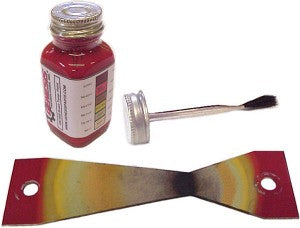
Why use brake cooling
Cooling of the brakes is essential - particularly on 'heavy braking' circuits or events. The heat generated during braking is stored in the discs and must be dissipated by air-flow through and around the disc. Failure to do this will result in reducing brake efficiency and in the extreme, increasing brake pedal travel and loss of retardation. Brake heat is removed by using ducted air directed into the 'eye' of the disc, through the internal vanes - and across the braking faces. It is important to ensure that the heated air escapes from the wheel and wheel-arch - otherwise air-flow is restricted and temperatures will increase. This is very much vehicle specific, there are no general rules.
Thermal paints are available which, applied to the outside diameter, are used to determine the maximum temperatures reached by the disc. Whilst there cannot be a general rule - because of varying circumstances - with the commonly available and used paints (Pink, Orange & Green) these are some pointers. If the Pink paint has turned white, this indicates that the disc has exceeded 610°C and it is probably too hot, so action is needed to correct the situation. If the orange has changed colour, it has reached 560°C, an acceptable running temperature and the green will change colour at 430°C which, generally, is below the optimum temperature range for racing pads - this could be so for a number of different reasons. Similarly, adhesive temperature indicator strips (THS0080x087 showing 121 -280°C) are available to indicate the maximum temperatures reached by the calipers.
Caliper temperatures must be kept within the capability of the brake fluid being used, otherwise, ultimately, vaporisation will occur with the result that the brake pedal travel will increase to the point that no hydraulic pressure can be generated and therefore, no braking force. Again and assuming that fresh, good quality Racing Brake Fluid is being used, if the caliper temperature indicators show a temperature of 200°C or more, this is cause for concern. It should be noted that although Racing Brake Fluids advertise a vaporisation temperature of 600°F (321°C) this is not totally representative of their performance in a vehicle, where inevitably there are some small amounts of air and moisture present both of which reduce vaporisation temperatures. So, new Racing Brake Fluid before each event should be the rule. In wet conditions, where tyre grip is reduced, cooling ducts should be partially closed to keep disc and pad temperatures up to their optimum. There is a point worth observing here: if, under normal dry conditions, brake temperatures are always cool, it may be that smaller, lighter brakes could be specified.


